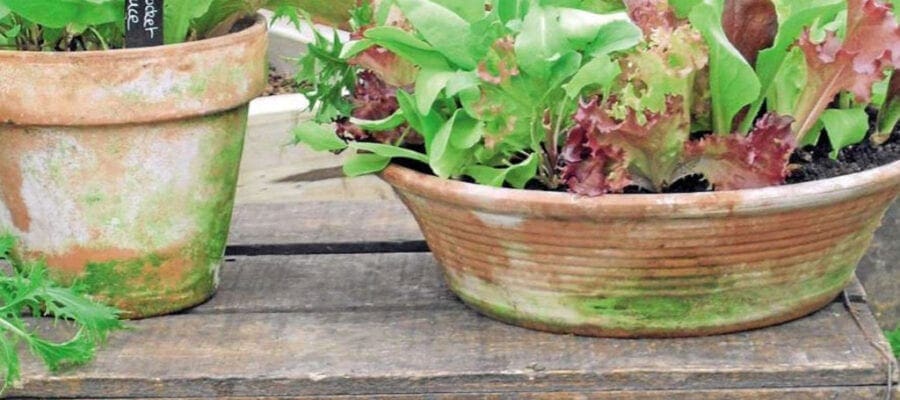
So, what’s a container? This depends on what crops you are growing, for example lettuce and salad leaves can be grown in quite shallow containers. A small trough 17cm (7in) deep and 30cm (12in) long would suffice for a few mixed cut and come again salad leaves.
Ideally, aim for atrough about 20cm (8in) wide, 60cm (2ft) long and at least 17cm (7in) deep. If you had a couple of these, you could sow two rows in one trough and then a week or two later two rows in the other and keep re-sowing as you use them. This will ensure a succession of crops throughout the summer. Place as near to the house as you can and you will be more likely to use them.
Carrots and root vegetables will need deeper containers at least 30cm (12in) deep, although you could grow the stump or round-rooted carrots like the variety ‘Parmex’ so depth is less of an issue. For large plants like courgettes, it is best to grow one plant in apot at least 30cm (12in) in diameter and preferably larger.
The bigger the container, the less often you will need to water and an even, uninterrupted water supply is one of the keys to success with growing veg.
Compost to use
The growing medium you use for the containers depends alittle on what you are intending to grow but for most crops including salads, carrots and most other container veg then use the cheapest multi-purpose compost you can find.
Sometimes this might be growing bags which you can either use as they are or use the compost to fill other containers. You could also use a loam-based John Innes No 2 compost which does not dry out as quickly as other types of compost. Large containers or raised beds will take a lot of filling and it may be cheaper to buy bulk bags or a load of top soil.
How to sow and grow

Scatter method Some veg can be sown direct in a pot by simply scattering the seed evenly over the surface of the compost. Good examples include carrots, radish, mixed salad leaves, lettuce, peas (for harvesting shoots), spinach.
When scattering seed, do not sow too thickly. Allow for about 6mm (1⁄4-1⁄2in) between seeds. Once the seedlings are established, they can be thinned out to allow more space between each plant.
If growing carrots and radish in containers, you are aiming to harvest them small as baby veg so they do not need as much space as they would in the ground.
In rows
If you have large containers or troughs, you may find it easier to sow in rows. Make a shallow seed drill with a stick and drop the seeds along the row, roughly about 6mm (1⁄4in) between each seed. The seedlings can be thinned when through.
Sow then plant
Some crops are best sown in seed trays or individual small pots or cell trays first before planting into their larger ‘permanent’ containers. These are usually the larger veg plants or crops that require some careful nurturing and heat first to get them growing.
These include tomatoes, cucumbers, courgettes, squashes, peppers and beans. Sow these in small pots or cell trays in a multi-purpose compost and either put in a propagator in agreenhouse or place on a warm windowsill. Once the seedlings are through and large enough to handle, they will need to be transplanted into small pots, one plant per pot, and grown on in agreenhouse or on a warm windowsill.
During April and early May, these crops can be placed outside on sunny days and brought inside at night if frosts are forecast. At this stage, they can be planted up into their larger permanent containers, but still keep them protected and do not place them outside permanently until all danger of frost has passed, which will usually be about the end of May/beginning of June depending on where you live.
Caring for container veg

The key to keeping container-grown veg happy, healthy and cropping well is never to allow the compost to dry out and to give adequate feed if necessary. Also, make sure you provide a sunny position.
Keep well watered
Many vegetables that you will be growing in containers are quick growing crops such as lettuce, salad leaves, radish and carrots. As long as these are kept well watered, they will produce good harvests. Watering may need to be more frequent for small containers and this may be twice a day if the weather is particularly hot, otherwise once every couple of days may suffice.
Successional sowing
It is a good idea to sow certain crops every couple of weeks. A good example are the cut and come again salad leaves or lettuce. These will grow quickly and you will get several days pickings from a potful; but after acouple of weeks, they go over and become tough and often hotter in taste. If you sow successionally, you will have a pot of younger fresh leaves ready to take over and you can lift and resow the older pot.











